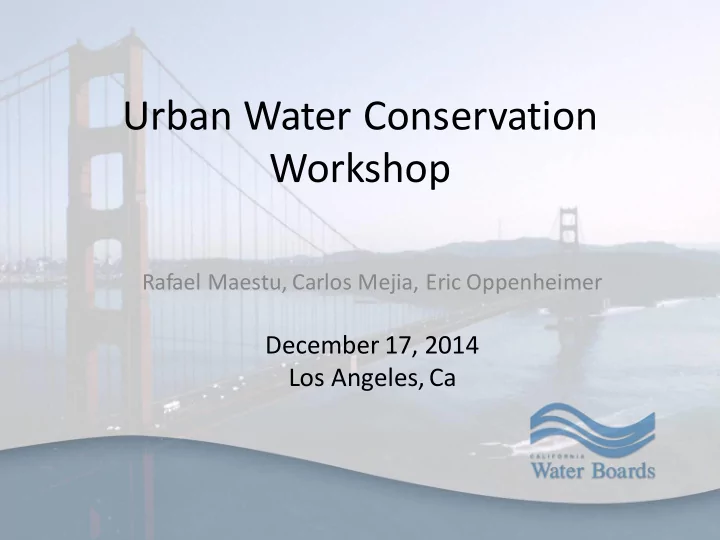

Urban Water Conservation Workshop Rafael Maestu, Carlos Mejia, Eric Oppenheimer December 17, 2014 Los Angeles, Ca
Water Conservation Emergency Regulation Timeline Drought Declaration January 17, 2014 Drought Executive Order April 25, 2014 Initial Water Board Survey May-June 2014 Board Adopts Emergency Regulation July 15, 2014 OAL Approves Emergency Regulation July 28, 2014 Water Production Reporting Begins August 15, 2014 Per Capita Water Use Reporting Begins October 15, 2014 Emergency Regulation set to Expire April 24, 2015
Small Water Supplier Actions • Informal Assessment of 10 Small Water Suppliers (representing approx. 50,000 People) – 40% provide a way to report water waste – 60% provide educational materials Action % Implementing as Mandatory Restriction on # days outdoor irrigation is allowed 20%* Restriction on hours of the day that outdoor irrigation is allowed 10% Prohibited uses consistent with emergency regulation 50% Hospitality restrictions 10% *only one supplier (10%) limits outdoor irrigation to 2 days per week
Large Supplier Restrictions on Outdoor Irrigation Days per Week Outdoor Irrigation is Allowed (Suppliers serving 200,000 or more) 8 8 7 6 # of Suppliers 5 4 4 4 4 3 3 2 1 1 1 0 1 2 3 3.5 4 6 7 Days per Week Allowed Based on a s ample of 25 largest water suppliers collectively serving ≈ 14.7 million people
Information Needs • Where and when is water being used? • Who is conserving? • What conservation actions are in place? • What is working? • How is water being used (indoor/outdoor) • What is the potential for water conservation?
Approach for data collection • Frequent data collection and reporting – Monthly web based reporting • Large water suppliers (>3000 connections) • Simple/Measure critical few • Informal Follow up with phone interviews
Metrics • Water Production • Residential Water • Population Served • Percentage Reduction (calculated) • R-GPCD • Mandatory restrictions • Additional data?
South Coast • 173 Retail Urban Water Suppliers • 20 million Californians represented • 56% of urban water in State Central Coast North Coast South Lahontan Colorado River 3% 1% North Lahontan 3% 3% >1% San Joaquin River 5% Tulare Lake 7% Sacramento River South Coast 9% 56% San Francisco Bay 13%
Mandatory Restrictions on Outdoor Water Use • 91% now implementing mandatory restrictions Water Suppliers Implementing Mandatory Restrictions 450 100% 90% 91% 400 90% 77 39 38 81% 80% 350 118 116 71% 70% 300 70% 60% 250 50% 200 369 362 40% 332 150 291 270 30% 100 20% 50 10% 0 0% June July August September October Mandatory Restrictions No Mandatory Restrictions Compliance Rate
Mandatory Restrictions on Outdoor Water Use - South Coast • 90% now implementing mandatory restrictions South Coast Water Suppliers Implementing Mandatory Restrictions 200 100% 90% 89% 180 90% 34 19 18 81% 160 80% 51 48 72% 71% 140 70% 120 60% 100 50% 158 155 80 40% 143 127 124 60 30% 40 20% 20 10% 0 0% June July August September October Mandatory Restrictions No Mandatory Restrictions Compliance Rate
Statewide Water Conservation Results Water Production June-October (Million Gallons) 240,000 242,425 240,392 2013 2014 220,000 224,262 218,350 215,446 212,724 208,823 200,000 193,268 188,249 180,000 175,582 160,000 140,000 June July August September October ≈ 90 Billion Gallons Saved June – October
South Coast Water Conservation Results South Coast Water Production June-October (Million Gallons) 2013 2014 130,000 120,000 118,049 117,782 116,088 113,035 110,000 109,484 108,519 109,629 104,519 100,000 98,787 97,384 90,000 80,000 June July August September October ≈ 21 Billion Gallons Saved June – October
October Water Production by Hydrologic Region and Percentage Reduction (Million Gallons) 120,000 25.0% 22.0% 20.0% 100,000 18.6% 15.5% 15.5% 15.0% 80,000 9.9% 10.0% 6.2% 5.2% 60,000 5.0% 40,000 1.4% 0.2% 0.0% 20,000 -5.0% -6.3% - -10.0% Production Oct 2013 Production Oct 2014 Percentage Oct Reduction State Average Oct Reduction 6.7%
Water Conservation Trend Water Production Percentage Reduction (compared to previous year) 11.6% 10.3% 7.6% 6.7% 4.3% Jun-14 Jul-14 Aug-14 Sep-14 Oct-14
Water Production Percentage Reduction (compared to previous year) All but South Coast Statewide South Coast 15.0% 13.3% 13.0% 12.6% 11.6% 10.3% 8.9% 7.9% 7.6% 7.5% 6.7% 4.3% -0.2% 1.7% 1.4% JUN-14 JUL-14 AUG-14 SEP-14 OCT-14
October 2014 Residential Gallons per Capita per Day • Highest R-GPCD figures > 500 • Lowest R-GPCD figures < 50 • Average October 2014 R-GPCD = 109 , down from 117 last year • 55 GPCD is the performance standard for indoor use
October 2014 Water Conservation Results R-GPCD October 2014 Average R-GPCD October 2014-2013 % Reduction 250.0 25.0% 22.0% 211.4 20.0% 18.6% 200.0 15.5% 179.6 15.0% 154.5 15.5% 9.9% 10.0% 135.8 138.6 150.0 6.2% 134.5 107.1 5.2% 5.0% 1.4% 0.2% 100.0 85.9 0.0% 77.5 71.2 -5.0% 50.0 -10.0% -10.6% 0.0 -15.0%
October 2014 Water Conservation Results October GPCD October % Reduction 600 20.00% 520 12.55% 500 10.00% 8.91% 455 6.82% 4.43% 4.15% 1.28% 1.57% 2.12% 1.96% 400 0.00% -4.20% -1.10% -3.20% -1.40% -2.00% -0.70% 354 -4.80% 305 279 -8.50% -9.50% 300 -10.00% 265 245 225 217 213 206 201 200 -11.30% -13.20% 200 -20.00% 100 -30.00% -33.50% - -40.00% "" "" "" "" "" "" "" "" "" "" "" "" "" "" "" "" "" "" "" "" "" "" "" ""
25.00% 20.00% 15.00% 10.00% 5.00% 0.00% - 100 200 300 400 500 -5.00% -10.00% -15.00%
Workshop Questions 1. What more should be done at the local and/or State level in the near-term to increase water conservation? 2. What additional conservation requirements, if any, should the State Water Board consider adopting if dry conditions persist into the new year? 3. What can be done to compel poorer performing areas to increase conservation? 4. What additional data should the State Water Board be collecting and how would it be used? 5. Others/ Ideas for incentivizing permeant conservation enhancements
Recommend
More recommend